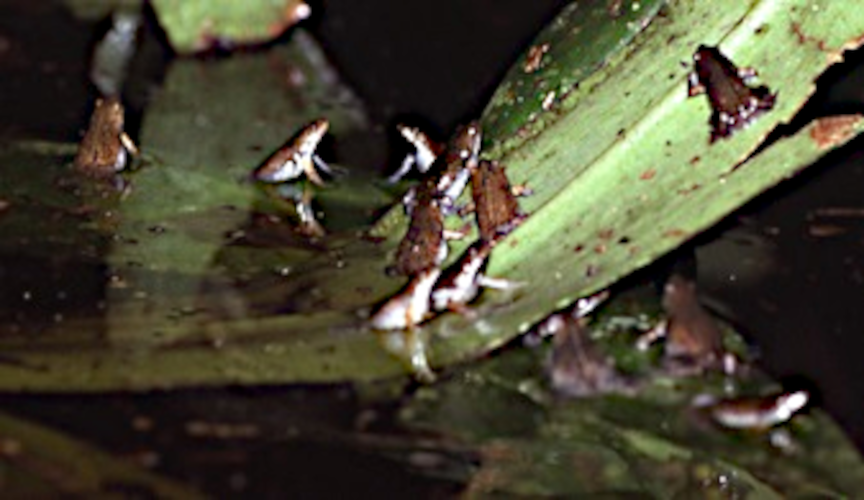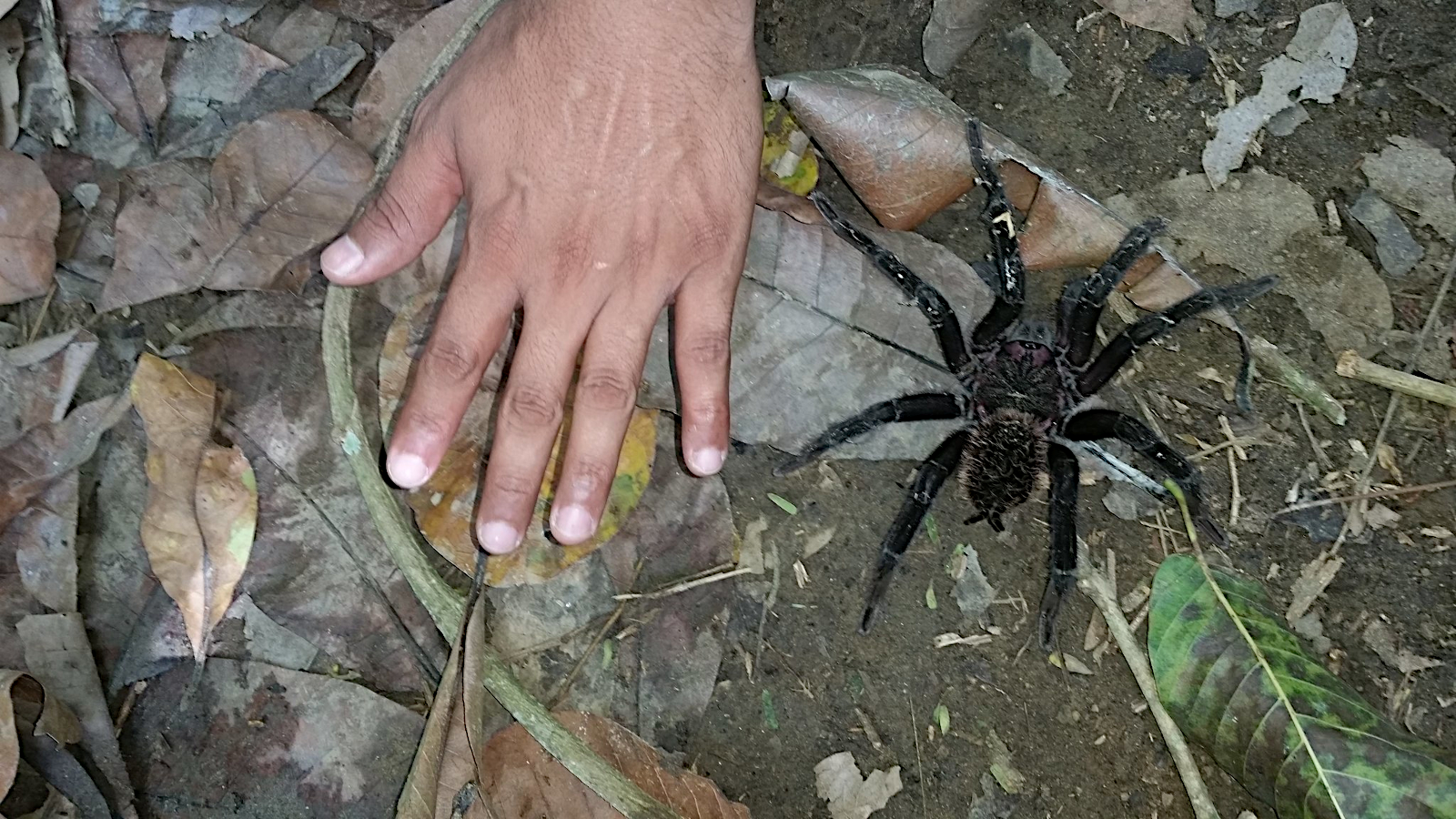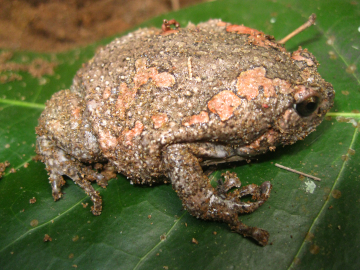Can a Tarantula and a Frog Get Along?
hive-196387·@agmoore·
0.000 HBDCan a Tarantula and a Frog Get Along?
The idea for this blog came to me when I was brainstorming for a post in another community, LMAC. My mind was busily working on ideas for a collage in which an entire village was covered by a spider web. I wanted to put other creatures in the collage so I started to explore species with whom spiders might have a symbiotic, or mutualist relationship. Surprisingly, I found a tiny amphibian with whom a species of tarantula lives peacefully, in what is believed to be a [mutualistic](https://familylifegoals.com/these-giant-tarantulas-are-best-friends-with-tiny-frogs-and-the-relationship-is-one-of-natures-best/) relationship. ##### <center>The Dotted Humming Frog and the Colombian Lesserblack Tarantula</center> **Colombian Lesserblack Tarantula, *Xenesthis Immanis***  *Image credit: José Gabriel Julio Guzmán. Used under [CC 4.0 license](https://commons.wikimedia.org/wiki/File:Xenesthis_immanis_101285784.jpg)* According to the website *Theraphosidae.be*, which appears to be dedicated to offering information about Tarantulas, the Colombian Lesserblack Tarantula may be [found](https://www.theraphosidae.be/en/xenesthis-immanis/) in: Colombia, Venezuela, and Ecuador. This arachnid is described as a terrestrial (as opposed to arboreal) bird spider. The description apparently means the spider is large enough to eat birds--though birds may be only occasional fare. Adults of both sexes reach a leg span of [about 8".](https://beyondthetreat.com/xenesthis-immanis/) The spider is [sexually dimorphic]((https://www.dictionary.com/browse/dimorphism)) (there are apparent differences [between the sexes](https://forums.frontier.co.uk/threads/most-beautiful-tarantulas-spiders-to-be-added-wishlist.526449/) in adulthood). Lifespan for female *Xenesthis immanis* may be 15 years. Males generally live to only 4 years. It's possible the shorter lifespan is partly due to the fact that the female [sometimes eats the male](https://kidadl.com/animal-facts/colombian-lesserblack-tarantula-facts) after mating. Females [are](https://beyondthetreat.com/xenesthis-immanis/) larger and heavier. There is another species of tarantula that has a greater reputation for eating birds: the [Goliath bird-eating spider.](https://nationalzoo.si.edu/animals/goliath-bird-eating-tarantula) The Goliath is said to be the largest spider in the world. **Goliath Bird-Eating Spider** https://www.youtube.com/watch?v=cBL-5mOGHt8 However, our featured spider today, the Colombian Lesserblack, is no slouch. It is known to eat a variety of animals, including small amphibians and insects. This is what makes its relationship with the tiny dotted humming frog so remarkable. **Dotted Humming Frog, *Chiasmocleis Ventrimaculata***  *Image credit: Andreas Schlüter. Used under [CC 2.5 license.](https://commons.wikimedia.org/wiki/File:Chiasmocleis_ventrimaculata01.jpg)* This minuscule frog (size range [between 20-24mm](https://amphibiaweb.org/species/2108)), may be [found](https://www.inaturalist.org/taxa/25068-Chiasmocleis-ventrimaculata) in moist forests and marshes of Bolivia, Brazil, Colombia, Ecuador, and Peru. The males of the species 'sing' together in a [chorus.](https://amphibiaweb.org/species/2108) According to *Amphibia Web*, this amphibian has "explosive reproduction". Why do frogs 'sing'? Actually the sound a frog makes is its 'call' and that call is almost always [sent out](https://australian.museum/blog/science/why-do-frogs-call/) by the male. The Australian Museum suggests this gender-specific behavior has a mating purpose. The male is announcing his presence. The 'song' is a kind of come hither advertisement. I couldn't find a recording of the dotted humming frog's call, I did find a compilation of frog calls on *Youtube*. https://www.youtube.com/watch?v=J1Sc78-TOFs Despite its diminutive size and noisy habits,however, the dotted humming frog manages to avoid becoming dinner for the very large lesserblack tarantula. Not only does the frog avoid being eaten, it apparently enjoys protection from its ordinarily lethal companion. Here's a video showing frog and spider together: https://www.youtube.com/watch?v=VKgQj9b0b2w It has been observed that both species benefit from this arrangement. What could the frog possibly offer the spider? Protection of the young. The diet of the frog includes [ants and flies.](http://www.isopoda.net/contents/the-odd-couple-spider-frog-mutualism-in-the-amazon-rainforest/) These opportunistic feeders would spell death to the young/eggs of the tarantula. By keeping the tiny frog around, the tarantula has a handy housekeeping staff. There's a nice picture on this Twitterfeed of the frogs and the tarantula, with tarantula young, cohabitating on a leaf: https://twitter.com/rainmaker1973/status/1248211500017254405?lang=en The Colombian lesserblack tarantula happens to be very maternal, so the mother places high value on her young. She carries [about a 100 spiderlings](https://pam.uni.lodz.pl/application/session/pqcmn/xenesthis-immanis-frog) in her egg sack. The mother may live with her offspring for a year, and has been known to [feed communally.](http://www.isopoda.net/contents/the-odd-couple-spider-frog-mutualism-in-the-amazon-rainforest/) Mother and young share tasty meals such as cockroaches, crickets, *and* small frogs. That is, small frogs that are *not* of the dotted humming variety. Both the [dotted humming frog](https://scienceblogs.com/tetrapodzoology/2009/07/03/tiny-frogs-and-giant-spiders) and the [Colombian lesserblack tarantula](https://www.theraphosidae.be/en/xenesthis-immanis/) are nocturnal. The tarantula prefers to burrow in the ground. Often it is an [opportunistic](https://www.theraphosidae.be/en/xenesthis-immanis/) burrower. Like all tarantulas, the Colombian lesserblack is a hunter. However, unlike some other tarantulas, the lesserblack does not spin a web. When night falls, it waits outside its burrow and pounces on prey. Legs [attached to its abdomen](https://kidadl.com/animal-facts/colombian-lesserblack-tarantula-facts) are sensory organs and help the spider to detect prey, or to sense danger and flee. **Colombian Lesserblack Compared to Human Hand**  *Image credit: José Gabriel Julio Guzmán. Used under [CC 4.0 license.](https://commons.wikimedia.org/wiki/File:Xenesthis_immanis_101500522.jpg)* How does the Colombian lesserblack tarantula distinguish its amphibian housekeeper from other frogs which are destined to be dinner? It is believed that the tarantula recognizes its ally through smell. Researchers believe the reaction is instinctual. It has been observed that young tarantulas will [jump on a frog](https://scienceblogs.com/tetrapodzoology/2009/07/03/tiny-frogs-and-giant-spiders) and then move off and leave it in peace. Not surprisingly, the Colombian lesserblack is considered a rather docile spider, as tarantulas go. If startled, it is more likely to retreat than attack. One of its first defensive measures would be to release irritating hairs ([urticating setae](https://www.theraphosidae.be/en/xenesthis-immanis/)) by raising the legs and exposing the abdomen. Here is a Youtube video explaining the way the spider uses these hairs (advance the video to around 2.16 to hear about this species). https://www.youtube.com/watch?v=rNqatgWFbzc While this tarantula is [not considered highly](https://biomedicalephemera.tumblr.com/post/19439864037/xenestis-colombiana-xenesthis-immanis-the) venomous, it can inflict [great harm](https://biomedicalephemera.tumblr.com/post/19439864037/xenestis-colombiana-xenesthis-immanis-the) through its setae (hairs). These may elicit strong allergic reactions and if inhaled could cause extreme respiratory distress. If embedded in the eye, they can cause severe damage. **Other Tarantulas Have Mutualistic Relationships** While doing this blog, I learned that this mutualism (between frog and tarantula) is not unique to South America. It occurs all [over the world.](http://www.isopoda.net/contents/the-odd-couple-spider-frog-mutualism-in-the-amazon-rainforest/) The behavior has been observed in arboreal tarantulas in Sri Lanka and in a species of tarantula in Mexico. **Ornate Tiger Spider *Poecilotheria Ornata*, Sri Lanka**  *Image credit: Morkelsker. Used under [public domain license.](https://commons.wikimedia.org/wiki/File:Poecilotheria_ornata_-_female_-_top_view.jpg) This tarantula is a fierce hunter but lives in peace (mutualistically) with the [*Kaloula taprobanica *](https://tapro.sljol.info/articles/abstract/10.4038/tapro.v1i1.2772/) in the forests of Sri Lanka* ***Kaloula Taprobanica Frog*, Also Known as Nagao's Pug-Snout Frog**  *Image credit: Vijayakumarblathur. Used under a [CC 4.0 License.](https://commons.wikimedia.org/wiki/File:Kaloula_taprobanica.JPG)* [According to](http://www.isopoda.net/contents/the-odd-couple-spider-frog-mutualism-in-the-amazon-rainforest/) the biologist Francesco Tomasinelli, mutualistic relationships between frogs and tarantulas may be more widespread, and involve more diverse species, than has so far been observed. **Conclusion** I learned about the mutualistic relationship between the tarantula and the frog while I was doing an art project. This serendipitous discovery supports my long-held conviction that there is not separation between art and science. If we are open to the interconnectedness of nature and the universe, then I believe we should also be open to the interconnectedness between so-called disciplines. I hope you, my readers, are as entertained by my excursion into arachnids and amphibians as I have been. Who knows where blogging will take me tomorrow. Wishing health, peace and a creative day to all. Thank you for reading my blog. Hive on! <center></center> <center></center> <center></center> **Selected Sources Used in Writing This Blog** 1.https://nationalzoo.si.edu/animals/goliath-bird-eating-tarantula 2.https://blogs.scientificamerican.com/tetrapod-zoology/tiny-frogs-and-giant-spiders-best-of-friends/ 3.https://www.jstor.org/stable/2388434 4.http://www.isopoda.net/contents/the-odd-couple-spider-frog-mutualism-in-the-amazon-rainforest/ 5.https://projects.ncsu.edu/cals/course/ent425/library/compendium/diptera.html 6.https://www.theraphosidae.be/en/xenesthis-immanis/ 7.https://biomedicalephemera.tumblr.com/post/19439864037/xenestis-colombiana-xenesthis-immanis-the 8.https://www.inaturalist.org/taxa/25068-Chiasmocleis-ventrimaculata 9.https://www.ncbi.nlm.nih.gov/books/NBK535394/ 10.https://beyondthetreat.com/xenesthis-immanis/ 11.https://familylifegoals.com/these-giant-tarantulas-are-best-friends-with-tiny-frogs-and-the-relationship-is-one-of-natures-best/ 12.https://scienceblogs.com/tetrapodzoology/2009/07/03/tiny-frogs-and-giant-spiders 13.https://kidadl.com/animal-facts/colombian-lesserblack-tarantula-facts 14.https://www.youtube.com/ 15.https://tapro.sljol.info/articles/abstract/10.4038/tapro.v1i1.2772/ 16.https://en.wikipedia.org/wiki/Uperodon_nagaoi 17.https://www.youtube.com/ 18.https://forums.frontier.co.uk/threads/most-beautiful-tarantulas-spiders-to-be-added-wishlist.526449/
👍 creative-pi, stemd, gangstalking, katerinaramm, hadji, ummar, aboutheraklion, trumpman, marcybetancourt, steemychicken1, ruth-girl, brisby, afril, yusrizakaria, mutiahanum, pokerm, eve66, jaraumoses, gerber, ezzy, exyle, steem.leo, mice-k, polish.hive, dcityrewards, hivecur, reazuliqbal, tesaganewton, daan, dune69, iansart, shitsignals, felander, caladan, emrebeyler, pkocjan, freddio, steem.services, linco, swisswitness, dlike, engrave, followjohngalt, cakemonster, mfblack, imagenius, milu-the-dog, triplea.bot, tiffin, ribary, dcrops, karja, berthold, fatman, thefoundation, yogacoach, theinkwell, dbzfan4awhile, carolkean, sunravelme, raj808, oluwashinaayomi, letalis-laetitia, hillarypowers, abkevwe, apeboy, ghostonchronic, sbi3, sbi-tokens, sneakyninja, thedailysneak, kneelyrac, art.vieanna, muelli, liverpool-fan, successchar, lordbutterfly, hivelist, mathowl, omstavan, jd4e, mechanicalowl, regularowl, thomasthewolf, heystack, nobyeni, samve, yggdrasil.laguna, abh12345.stem, brofund-stem, meestemboom, adamada.stem, juecoree.stem, solominer.stake, solominer.stem, modeprator, slider2990, cd-stem, dorkpower, enforcer48, aninsidejob, babytarazkp, memehub, freebornsociety, memecurator, memesupport, bearbear613, agmoore, dronegirl, rockface, iovoccae, steemlandia, shasta, zuerich, gentleshaid, aamin, stemng, samest, kingabesh, the.chiomz, joelagbo, djoi, temitayo-pelumi, teemike, lemouth, steemstem-trig, lesmouths-travel, minnowbooster, howo, aboutcoolscience, steemstem, roelandp, dna-replication, samminator, tsoldovieri, kenadis, michaelwrites, afarina46, alphahippie, chubb149, skapaneas, lamouthe, techslut, valth, dhimmel, mobbs, alexander.alexis, abigail-dantes, noloafing, enzor, lottje, fejiro, sco, branbello, intrepidphotos, fragmentarion, real2josh, dexterdev, geopolis, alexdory, francostem, gadrian, deholt, motherofalegend, marcuz, purelyscience, pboulet, meanroosterfarm, cowpatty, stem.witness, mowemu, delilhavores, mengene, stemsocial, verite, curie, walterjay, ludmila.kyriakou, wilians, bhoa, sankysanket18, flugschwein, de-stem, crowdwitness, jeffmackinnon, solcycler, thelemonjay, zonguin, oscurity, doctor-cog-diss, gadrian-sp, imbartley, tfeldman, revo, upme, phgnomo, steem4all, grizzle, didic, atomcollector, doikao, croctopus, qberry, cheese4ead, hairgistix, epicdice, lyubo19, michelle.gent, tristancarax, gabriele-gio, zerotoone, hhayweaver, zyx066, minnowpowerup, blervin, therising, bflanagin, armandosodano, steemegg, cosplay.hadr, hadrgames, newsflash, lightproject, neumannsalva, cahlen, gordon92, proxy-pal, cloh76, cliffblank, boynashruddin, robinhaney, finkistinger, diabolika, bahagia-arbi, battebilly, steveconnor, beverages, rambutan.art, yaelg, thelittlebank, edithbdraw, rem-steem, coinlogic.online, hive-world, justyy, modernzorker, aboutyourbiz, appleskie, steemed-proxy, giddyupngo, bernardino, jmjury, newtrailers, likwid, quinnertronics, treefiddybruh, coffeebender, joshglen, dashfit, sustainablyyours, stayoutoftherz, bradfordtennyson, steemvault, outlinez, frissonsteemit, cryptocopy, kylealex, rosana6, gunthertopp, thelordsharvest, trevorpetrie, vicesrus, miroslavrc, bil.prag, cryptological, fractalfrank, hornetsnest, rondonshneezy, juanmiguelsalas, kalinka, redrica, guada1, stickchumpion, cryptononymous, braveboat, cataluz, itchyfeetdonica, marcolino76, stahlberg, reizak, irgendwo, vittoriozuccala, c0wtschpotato, indigoocean, olumzy, palasatenea, madmanmusic, steemstorage, vicnzia, specialfeelings, scalextrix, stephen.king989, apsu, rt395, jayna, nitego, singhrajat, pandasquad, themonkeyzuelans, ilovecryptopl, brianoflondon, steemcryptosicko, devann, bit4bit, filosof103, ph1102, schmidi, carmenm20, surya2adiga, limn, torico, dbooster, utube, takowi, julialee66, outtheshellvlog, navyactifit, bluemaskman, iamsaray, mind.force, kimzwarch, meno, apon318, jigstrike, minerthreat, bubblegif, thecryptodrive, cnfund, dejan.vuckovic, pechichemena, zipsardinia, fineartnow, fantasycrypto, zipporah, flyerchen, cryptocoinkb, sadbear, javyeslava.photo, josesalazar200, steemean, endersong, tggr, dmoonfire, yunnie, fengchao, hiveonboard, miroslaviv, redpalestino, notconvinced, lastminuteman, federacion45, roomservice, scrodinger, coindevil, toocurious, teukurival, straykat, smjn, jeenger, photohunt, gwilberiol, diabonua, steemxp, the.success.club, chickenmeat, solox, peterpanpan, nbs.gmbh, drricksanchez, voter000, netaterra, sokha, howiemac, vanje, ambyr00, tazbaz, neneandy, positiveninja, ambifokus, lotto-de, authentika, therealyme, serylt, perpetuum-lynx, driptorchpress, dbddv01, rihc94, chasmic-cosm, autobodhi, gradeon, kiemurainen, roamingsparrow, blewitt, verhp11, blainjones, mcsvi, zest, ibt-survival, forykw, erick1, mamalikh13, bluefinstudios, gabrielatravels, mproxima, felixgarciap, sanderjansenart, vixmemon, lefty619, robibasa, titan-c, grapthar, randumb, proto26, stem-espanol, lorenzor, iamphysical, azulear, carloserp-2000, yrmaleza, miguelangel2801, emiliomoron, tomastonyperez, elvigia, josedelacruz, erickyoussif, andrick, yusvelasquez, acont, fran.frey, giulyfarci52, wilmer14molina, bigtakosensei, yehey, insaneworks, uche-nna, robmojo, fredrikaa, fourfourfun, psicoluigi, peaceandwar, fatkat, drifter1, mammasitta, binkyprod, prapanth, danile666, cordeta, mariusfebruary, alvin0617, danaedwards, shinedojo, drsensor, sciencevienna, marcoriccardi, bennettitalia, vaultec, eric-boucher, stevenwood, robertbira, eliaschess333, nicole-st, adam.tran, yourfuture, egotheist, lk666, flatman, chrisdavidphoto, oghie, cyprianj, ennyta, endopediatria, anaestrada12, uwelang, chromiumone, agmoore2, borislavzlatanov, amatom, limka, onthewayout, mundo.curioso, careassaktart, photographercr, tfranzini, tonimontana, sunnyag, steemitboard, kryptik.tigrrr3d, one-eye, teukuaroel, stemcur, borjan, quantumg, generikat,